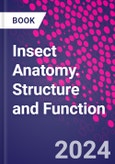Insect Anatomy: Structure and Function provides both morphological and anatomical descriptions of insect tissues and organs using updated methods. Insects play important roles in diverse ecosystems, with subsequent, tremendous impacts on human society through disease, agriculture effects, and more. Both beneficial and detrimental insect species continuously challenge agriculture and medicine. Written by international experts of insect morphology and anatomy, this book offers concise descriptions of all part of an insect's anatomy, including the brain and nervous system, tracheal system, blood, reproductive organs, and kidney system.
The book also covers external insect parts such as antennae, wings and different forms of insect epidermis. Insect tissues and organs are analyzed as they relate to gene and protein function in distinct types of cells, tissues, and organs.
The book also covers external insect parts such as antennae, wings and different forms of insect epidermis. Insect tissues and organs are analyzed as they relate to gene and protein function in distinct types of cells, tissues, and organs.
Table of Contents
1. Introduction to Insect Organs and Tissues B. Moussian2. Brain and Nervous System Development During Embryogenesis
3. Morphological and Differentiation of the Tracheal System
4. The Insect Kidney and Malpighian Tubules
5. Epidermis
6. Haemolymph or Insect Blood
7. Fat Body and Oenocytes
8. Heart, Visceral, and Somatic Muscles
9. Salivary Glands
10. Intestinal Tracts
11. Wings
12. Antennae
13. Reproductive Organs
14. Organ and Tissue Communication








